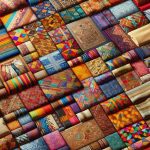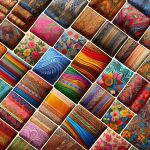Are you ready to discover the enchanting world of naturally dyed silk? Brace yourself for a journey that unravels the historical significance, diverse sources, and vibrant color palette of these mesmerizing fabrics.
Learn about the sustainable benefits and care tips for maintaining the magic of these textiles. Prepare to be inspired as we delve into the modern applications that bring this ancient art form to life.
Get ready to be captivated by the allure of naturally dyed silk.
Table of Contents
Historical Significance
The historical significance of naturally dyed silk lies in its ability to showcase the rich cultural heritage and craftsmanship of ancient civilizations. In understanding the historical context of naturally dyed silk, we can appreciate the cultural traditions that have shaped the art of dyeing fabric for centuries.
Throughout history, various civilizations have developed their own unique techniques and color palettes for dyeing silk. From the vibrant reds of ancient China to the intricate patterns of the Byzantine Empire, the art of naturally dyeing silk has served as a visual representation of a society’s values, beliefs, and artistic expressions.
In ancient times, the process of dyeing silk was a closely guarded secret, passed down from one generation to the next. The knowledge and expertise required to achieve vibrant and long-lasting colors were highly valued, making dyers an integral part of their communities. The art of dyeing silk became intertwined with cultural traditions, rituals, and social hierarchies.
Natural Dye Sources
To explore natural dye sources for silk, you can start by researching plants, insects, and minerals that have been historically used to create vibrant and sustainable colors. When it comes to the dyeing process, plant-based dyes are a popular choice.
Plants have been used for centuries to create beautiful and long-lasting dyes. For example, indigo plants produce a deep blue dye that has been used in many cultures around the world. Madder root, on the other hand, can be used to create shades of red, orange, and pink. Other plants, such as turmeric, onion skins, and avocado pits, can also be used to create a wide range of colors.
Insects are another source of natural dyes. Cochineal, a small insect found on cacti, produces a vibrant red dye that was highly valued in ancient civilizations. Similarly, lac insects secrete a resin that can be used to create shades of red, orange, and purple.
Minerals, such as iron and copper, can also be used to create natural dyes. These minerals can be combined with other ingredients to produce different shades of colors.
Dyeing Techniques
Now let’s explore the fascinating ancient dyeing methods and sustainable natural dyes used in the art of naturally dyeing silk.
These techniques have been passed down through generations, preserving traditional practices while embracing eco-friendly alternatives.
Ancient Dyeing Methods
Explore the rich history of ancient dyeing methods and discover their timeless beauty and craftsmanship through the use of natural dyes on silk. These dyeing traditions have been passed down through generations, preserving the art of creating vibrant and intricate patterns on delicate silk fabrics. The use of traditional recipes enhances the depth and richness of the colors, making each piece a work of art.
As you delve into the world of ancient dyeing methods, you’ll be captivated by the following emotions:
-
Awe: Witness the stunning array of colors that can be achieved through natural dyes, showcasing the incredible skill and knowledge of the dyers.
-
Wonder: Marvel at the intricate techniques used to create mesmerizing patterns, from tie-dye to resist dyeing.
-
Connection: Feel a deep sense of connection to the past as you learn about the cultural significance of these dyeing methods in different regions.
-
Appreciation: Develop a profound appreciation for the craftsmanship and dedication required to produce these exquisite silk textiles, reflecting the ingenuity and creativity of ancient civilizations.
Immerse yourself in the ancient dyeing methods, and experience the magic of transforming silk into wearable art.
Sustainable Natural Dyes
Discover four sustainable natural dyeing techniques that can be used to create vibrant and eco-friendly colors on silk fabrics. These techniques not only produce beautiful hues but also have a minimal environmental impact, making them a perfect choice for ethical fashion. By using natural ingredients, such as plants, fruits, and minerals, these dyes avoid the harmful chemicals often found in synthetic dyes. The table below showcases the four techniques along with their respective ingredients and resulting colors. With these sustainable dyeing techniques, you can embrace a more eco-conscious approach to fashion, ensuring that your silk garments are not only visually stunning but also ethically produced.
| Technique | Ingredients | Resulting Color |
|---|---|---|
| Plant-Based Dyeing | Indigo, turmeric, madder root | Blue, yellow, pink |
| Fruit Dyeing | Avocado pits, pomegranate skins | Pink, peach |
| Mineral Dyeing | Iron, copper, alum | Gray, green, maroon |
| Natural Mordant Dyeing | Tannin, alum, vinegar | Various shades and hues |
Vibrant Color Palette
Get ready to explore the vibrant color palette that naturally dyed silk has to offer.
With natural dyes, you can enjoy the advantages of brighter and more saturated hues compared to synthetic dyes.
Not only do these colors pop, but they also offer excellent colorfastness and longevity, ensuring your silk creations stay vibrant for years to come.
Natural Dye Advantages
Achieve a vibrant color palette with the advantages of natural dyes when dyeing silk.
Natural dyes offer several benefits that make them a sustainable and eco-friendly choice for coloring silk fabrics. Here are four reasons why natural dyes provide a vibrant color palette:
-
Eco-friendly: Natural dyes are derived from plants, minerals, and insects, making them biodegradable and non-toxic. By choosing natural dyes, you contribute to a healthier environment.
-
Rich and complex hues: Natural dyes produce colors that are unique and often have a depth and complexity that synthetic dyes can’t replicate. This creates a visually stunning and vibrant color palette for your silk garments.
-
Colorfastness: Natural dyes have excellent colorfastness, meaning they retain their vibrant hues over time, even after repeated washing and exposure to sunlight. This ensures that your silk fabrics stay beautiful and vibrant for years to come.
-
Harmonious blends: Natural dyes can be easily mixed or layered to create a wide range of shades and tones. This allows you to experiment and achieve a harmonious blend of colors, adding depth and dimension to your silk creations.
With the advantages of natural dyes, you can create a vibrant and visually captivating color palette for your silk fabrics while also making an eco-friendly choice.
Colorfastness and Longevity
With its excellent colorfastness and longevity, natural dyes offer a vibrant and visually captivating color palette for your silk fabrics. Unlike synthetic dyes, which often fade over time and with exposure to sunlight, natural dyes have proven to be more resistant to color fading. This means that your silk garments will retain their beautiful hues for longer, allowing you to enjoy them for years to come.
Additionally, natural dyes are eco-friendly alternatives to synthetic dyes, as they’re derived from plants, insects, and minerals. They’re non-toxic and biodegradable, minimizing harm to the environment.
Sustainable Benefits
Experience the numerous sustainable benefits of naturally dyed silk through its minimal environmental impact and biodegradable properties. Choosing eco-friendly options like naturally dyed silk can significantly reduce the negative environmental impact caused by conventional dyeing processes. Here are four reasons why embracing naturally dyed silk is a great choice for the planet:
-
Reduced Chemical Usage: Naturally dyed silk eliminates the need for harmful chemicals used in synthetic dyeing processes. By opting for natural dyes derived from plants, insects, or minerals, you contribute to a cleaner and healthier environment.
-
Water Conservation: The dyeing of silk using natural dyes requires significantly less water compared to conventional dyeing methods. By using natural dyes, you help conserve this precious resource and minimize water pollution.
-
Biodiversity Preservation: Natural dyes are often sourced from renewable resources, such as plants and insects. By supporting the use of these materials, you contribute to the preservation of biodiversity and help protect fragile ecosystems.
-
Biodegradability: Unlike synthetic dyes, natural dyes are biodegradable, meaning they can decompose harmlessly in the environment. By choosing naturally dyed silk, you ensure that your clothing or textiles won’t contribute to the growing problem of non-biodegradable waste.
Care and Maintenance Tips
To effectively care for and maintain naturally dyed silk, follow these easy tips. Silk preservation is essential to ensure that your garments or home decor items retain their beauty and longevity.
First and foremost, always check the care label of your silk products for any specific instructions.
When it comes to cleaning, opt for eco-friendly methods to protect both the environment and your silk. Avoid using harsh chemicals or bleach, as they can damage the fabric and fade the natural dyes. Instead, gently hand wash your silk items using a mild detergent or a solution of vinegar and water. Avoid wringing or twisting the fabric and instead, gently squeeze out excess water.
To dry, lay the silk flat on a clean towel and let it air dry. Avoid direct sunlight as it can cause the colors to fade.
Lastly, store your silk items in a cool and dry place, away from direct sunlight or excessive humidity.
Following these care and maintenance tips will help prolong the life and beauty of your naturally dyed silk products.
Exploring Modern Applications
To further understand the versatility of naturally dyed silk, explore its modern applications in fashion, home decor, and artistic creations.
In today’s world, naturally dyed silk has made a remarkable comeback, revolutionizing the modern fashion industry and pushing the boundaries of creativity. Here are four ways in which naturally dyed silk is making its mark:
-
Sustainable Fashion: With an increasing demand for eco-friendly and ethically produced clothing, naturally dyed silk is gaining popularity among fashion designers and conscious consumers. Its vibrant hues and unique textures bring a touch of luxury to sustainable fashion.
-
Textile Innovation: The textile industry is embracing the beauty of naturally dyed silk, incorporating it into innovative fabrics and materials. This fusion of traditional craftsmanship and modern technology is creating textiles that aren’t only visually stunning but also environmentally friendly.
-
Home Decor: From luxurious bedding to elegant draperies, naturally dyed silk adds a touch of sophistication to any home decor. Its lustrous sheen and soft drape make it a perfect choice for creating a cozy and stylish ambiance.
-
Artistic Expression: Artists and artisans are using naturally dyed silk as a canvas for their creations. The vibrant colors and organic patterns of naturally dyed silk inspire unique and captivating artworks, pushing the boundaries of traditional art forms.
Frequently Asked Questions
Can Naturally Dyed Silk Be Used for Everyday Clothing, or Is It More Suited for Special Occasions?
Naturally dyed silk can be used for everyday clothing or special occasions. Its vibrant colors and luxurious feel make it versatile. You’ll love the unique touch it adds to your wardrobe.
What Are Some Common Challenges or Difficulties Faced When Dyeing Silk With Natural Dyes?
When dyeing silk with natural dyes, challenges and difficulties may arise. Techniques like mordanting and achieving color fastness can be tricky. However, with practice and experimentation, you can overcome these obstacles and create beautiful naturally dyed silk garments.
Are There Any Specific Care Instructions That Need to Be Followed to Maintain the Vibrancy of Naturally Dyed Silk?
To maintain the vibrancy of naturally dyed silk, follow specific care instructions. These instructions ensure the longevity of your silk garments. Using natural dyes provides benefits like eco-friendliness and a unique, beautiful color palette.
How Does the Cost of Naturally Dyed Silk Compare to Silk Dyed Using Synthetic Dyes?
The cost of naturally dyed silk may be higher compared to silk dyed with synthetic dyes. However, it’s important to consider the environmental impact. Naturally dyed silk is more sustainable and supports eco-friendly practices.
Can Naturally Dyed Silk Be Combined With Other Fabrics, Such as Cotton or Wool, in a Single Garment?
Yes, naturally dyed silk can be combined with other fabrics like cotton or wool in a single garment. This offers you the advantage of creating unique, sustainable pieces that showcase the beauty of both materials.
- The Chemistry Behind Fabric Production - July 18, 2024
- Innovations in Fabric Moisture Management - July 18, 2024
- How Performance Fabrics Are Engineered - July 18, 2024







